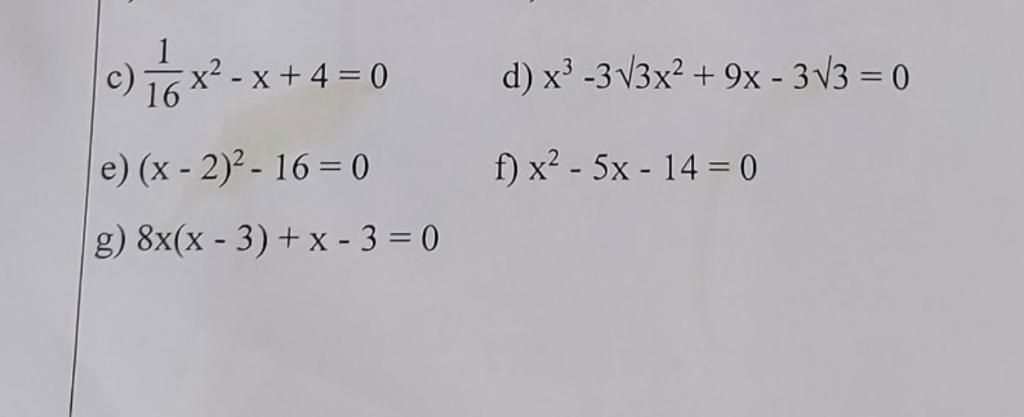 làm giúp e f(x) - g(x) vs ạ
làm giúp e f(x) - g(x) vs ạ
Hãy nhập câu hỏi của bạn vào đây, nếu là tài khoản VIP, bạn sẽ được ưu tiên trả lời.


\(e,\left(x-2\right)^2-16=0\\ \Leftrightarrow\left(x-6\right)\left(x+2\right)=0\\ \Leftrightarrow\left[{}\begin{matrix}x=6\\x=-2\end{matrix}\right.\\ f,x^2-5x-14=0\\ \Leftrightarrow\left(x-7\right)\left(x+2\right)=0\\ \Leftrightarrow\left[{}\begin{matrix}x=7\\x=-2\end{matrix}\right.\\ g,8x\left(x-3\right)+x-3=0\\ \Leftrightarrow\left(8x+1\right)\left(x-3\right)=0\\ \Leftrightarrow\left[{}\begin{matrix}x=-\dfrac{1}{8}\\x=3\end{matrix}\right.\)

\(\Leftrightarrow4x^2+x-8x-2-4x^2-27x=1\)
=>-34x=3
hay x=-3/34

f(2)=g(0)
=> c=5
f(1)=g(1)
=> a+b+c=2 mà c=5 => a+b=-3 (1)
f(-1)=g(3)
=>9a+3b+c=2 mà c=5= > 9a+3b=-3=> 3a+b=-1(2)
(2)-(1) ta được:
2a=2=>a=1=> b=-4
VẬy g(x)=x^2-4x+5
t i ck ủng hộ tui nha

Ta có: \(\left(x^{3n}+y^{3n}\right)\left(x^{3n}-y^{3n}\right)=-x^{6n}-y^{6n}\)
\(\Leftrightarrow x^{6n}-y^{6n}=-x^{6n}-y^{6n}\)
\(\Leftrightarrow n\in\varnothing\)

a) Ta có:
f(0) = -2.03 + 3.02 - 0 + 5 = 0 + 0 - 0 + 5 = 5
g(-1) = 2.(-1)3 - 2.(-1)2 + (-1) - 9 = -2 - 2 - 1 - 9 = -14
b) f(x) + g(x) = (-2x3 + 3x2 - x + 5) + (2x3 - 2x2 + x - 9)
= -2x3 + 3x2 - x + 5 + 2x3 - 2x2 + x - 9
= (-2x3 + 2x3) + (3x2 - 2x2) - (x - x) + (5 - 9)
= x2 - 4
f(x) - g(x) = (-2x3 + 3x2 - x + 5) - (2x3 - 2x2 + x - 9)
= -2x3 + 3x2 - x + 5 - 2x3 + 2x2 - x + 9
= -(2x3 + 2x3) + (3x2 + 2x2) - (x + x) + (5 + 9)
= -4x3 + 5x2 - 2x + 14

\(D=4x^2-2x+3x\left(x-5\right)=4x^2-2x+3x^2-15x=7x^2-17x=7\left(-1\right)^2-17\left(-1\right)=24\)
\(E=x^{10}-2020x^9+2020x^8-2020x^7+...+2020x^2-2020x=x^9\left(x-2019\right)-x^8\left(x-2019\right)+x^7\left(x-2019\right)-...-x^2\left(x-2019\right)+x\left(x-2019\right)-x=x^9\left(2019-2019\right)-...+x\left(2019-2019\right)-2019=-2019\)

\(f\left(0\right)=2010\Rightarrow a.0^2+b.0+c=2010\Rightarrow c=2010\)
\(f\left(1\right)=2011\Rightarrow a.1^2+b.1+c=2011\Rightarrow a+b+c=2011\)
\(\Rightarrow a+b+2010=2011\Rightarrow a+b=1\) (1)
\(f\left(-1\right)=2012\Rightarrow a.\left(-1\right)^2+b.\left(-1\right)+c=2012\)
\(\Rightarrow a-b+c=2012\Rightarrow a-b+2010=2012\)
\(\Rightarrow a-b=2\Rightarrow a=b+2\)
Thế vào (1) \(\Rightarrow b+2+b=1\Rightarrow2b=-1\Rightarrow b=-\dfrac{1}{2}\)
\(\Rightarrow a=b+2=-\dfrac{1}{2}+2=\dfrac{3}{2}\)
\(\Rightarrow f\left(x\right)=\dfrac{3}{2}x^2-\dfrac{1}{2}x+2010\)
\(\Rightarrow f\left(-2\right)=\dfrac{3}{2}.\left(-2\right)^2-\dfrac{1}{2}.\left(-2\right)+2010=2017\)

\(f\left(x\right)-g\left(x\right)\)
\(=\left(10x^7-8x^5-6x^3+4x+\dfrac{1}{4}\right)-\left(9x^8-7x^6-5x^4+3x^2+\dfrac{3}{4}\right)\)
\(=10x^7-8x^5-6x^3+4x+\dfrac{1}{4}-9x^8+7x^6+5x^4-3x^2-\dfrac{3}{4}\)
\(=-9x^8+10x^7+7x^6-8x^5+5x^4-6x^3-3x^2+4x+\left(\dfrac{1}{4}-\dfrac{3}{4}\right)\)
\(=-9x^8+10x^7+7x^6-8x^5+5x^4-6x^3-3x^2+4x-\dfrac{1}{2}\)
lũy thừa tăng dần của biến mà ạ?